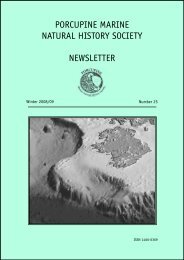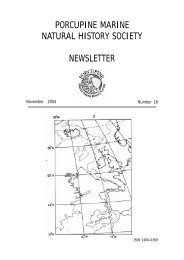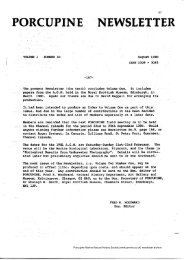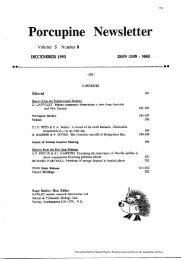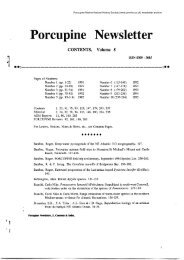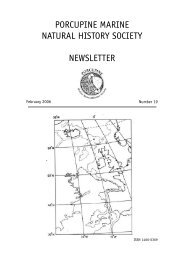PORCUPINE MARINE NATURAL HISTORY SOCIETY NEWSLETTER
PORCUPINE MARINE NATURAL HISTORY SOCIETY NEWSLETTER
PORCUPINE MARINE NATURAL HISTORY SOCIETY NEWSLETTER
Create successful ePaper yourself
Turn your PDF publications into a flip-book with our unique Google optimized e-Paper software.
32<br />
in New Zealand appears to be morphologically and<br />
reproductively identical to D. fimbriata (Gibson,<br />
1978). Since the two species are not found elsewhere<br />
in the world this suggests parallel evolution.<br />
If D. fimbriata and D. berkeleyi show parallel<br />
evolution but are the same species they would have<br />
to have had a world wide distribution at some time.<br />
They would, in this respect, be relic species and<br />
there is no indication of this. An alternative might<br />
be that they have been separated by continental<br />
drift. If this were so they would be expected, due<br />
to the absence of the interchange of genes, to have<br />
subsequently diverged into recognisably different<br />
species. In contrast the populations of D. fimbriata<br />
on either side of the North Atlantic have not diverged<br />
probably due to gene flow. They may still share the<br />
same gene pool. Epitokes, eggs and asexual products<br />
may be carried cross the Atlantic in, very probably,<br />
the Gulf Stream. Asexual products have been picked<br />
up in plankton hauls (Chadwick, 1927).<br />
Continental drift<br />
For the New Zealand species, D. berkeleyi, to be the<br />
same species as the European species, D. fimbriata,<br />
North America (Laurentia) could have been attached<br />
to South America and Africa (Gondwana) in the<br />
Precambrian some 500 million years ago (Figure).<br />
New Zealand would have been a part of this complex.<br />
The future North America would have separated<br />
during the Caledonian orogeny at about this time.<br />
(South America separated from African some 400<br />
million years later.)<br />
The Precambrian land mass appears to have existed<br />
in the southern hemisphere with the present day<br />
southern extremities of South Africa and South<br />
America lying at about 30 degrees south. This<br />
complex would have included Antarctica, Australia,<br />
India and presumably New Zealand. When Laurentia<br />
split from Gondwana it would have moved north<br />
to collide with Europe. It was then separated from<br />
Europe by the mid Atlantic tectonic split that parted<br />
South America from Africa, some 100 million years<br />
ago.<br />
Cambrian explosion and speciation<br />
Polychaetes first appeared during the Cambrian<br />
explosion 2 (Fauchald; Rouse & Pleijel) some 500<br />
million years ago when the southern complex existed<br />
(Lamb & Sington). When the land mass split, a<br />
population of Dodecaceria would have been left in<br />
New Zealand and another could have been carried<br />
north to Europe on what was to become the east<br />
coat of North America. The reason the two species<br />
are so similar, if not identical, may therefore be that<br />
they belonged to the same original population.<br />
PMNHS Newsletter No.24 Summer 2008<br />
If this scenario were correct, D. berkeleyi might<br />
be expected to be found in South Africa, Australia<br />
and South America all of which belonged to the<br />
Gondwana complex. So far as is known it is not. There<br />
are, however, other species of Dodecaceria (Gibson,<br />
1978) which subsequently reached different parts<br />
of the world. These species could have excluded<br />
D. fimbriata and D. berkeleyi through competition.<br />
This would support an argument for a cosmopolitan<br />
distribution of a single species of Dodecaceria.<br />
Living fossils?<br />
For D. berkeleyi and D. fimbriata to be the same<br />
species they would have to have remained unchanged<br />
since the Cambrian. Alternatively, they could have<br />
evolved in which case they would have “shadowed”<br />
one another: have taken the same evolutionary<br />
path. 3 This would in effect amount to convergent<br />
evolution.<br />
Whether the two species are the same could be<br />
resolved by DNA finger printing.<br />
Summary<br />
D. fimbriata and D. berkeleyi, based on morphological<br />
and reproductive similarities, could be the same<br />
species. The problem is that the two are found at<br />
opposite “poles” of the earth. One way the original<br />
population could have been separated to end up<br />
occupying this distribution is by continental drift<br />
that occurred in the Cambrian. They may have<br />
changed very little since then. Alternatively they<br />
show parallel evolution.<br />
Acknowledgements<br />
I wish to thank Professor Aubrey Manning of the<br />
University of Edinburgh for his helpful comments.<br />
References<br />
Chadwick H. C., (1927) The occurrence of Dodecaceria<br />
concharum at Port Erin, Report of the Oceanic<br />
Department of the University of Liverpool, 41,<br />
28-29.<br />
Fauchald K., Polychaete distribution patterns, or:<br />
can animals with Palaeozoic cousins show large-scale<br />
geographical patterns? The proceedings of the First<br />
International Polychaete Conference, (Editor P. A.<br />
Hutchings) The Linnean Society of New South Wales,<br />
1984, pp 1-6.<br />
Gibson P. H., (1978) Systematics of Dodecaceria,<br />
Zoological Journal of the Linnean Society, 63,<br />
275-287.<br />
Gibson P. H., (1979) The specific status of the two<br />
cirratulid polychaetes, Dodecaceria fimbriata and<br />
Dodecaceria caulleryi, compared by their morphology



